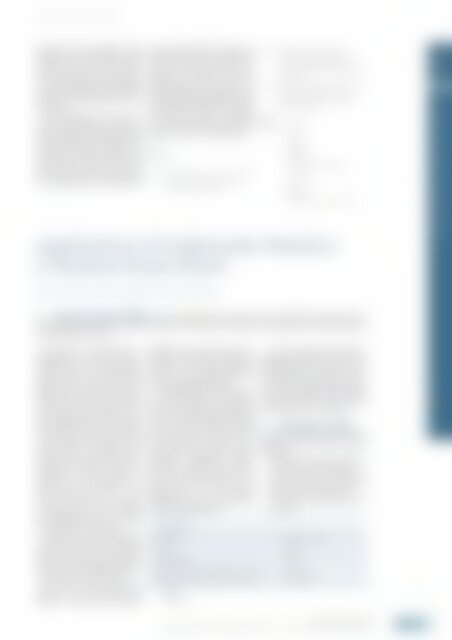atw 2018-05v6
You also want an ePaper? Increase the reach of your titles
YUMPU automatically turns print PDFs into web optimized ePapers that Google loves.
<strong>atw</strong> Vol. 63 (<strong>2018</strong>) | Issue 5 ı May<br />
suggestions from European Utility<br />
Requirements (EUR), WENRA safety<br />
reference levels, and IAEA introduction<br />
of the DEC term and concept into<br />
the safety standards series. Examples<br />
of a use of this approach for Dukovany<br />
and Temelín safety analyses have been<br />
presented.<br />
The programme for severe accidents<br />
for Czech NPPs is very extensive,<br />
this contribution included mainly the<br />
activities related to the Temelín NPP,<br />
but also the Dukovany NPP has own<br />
program and activities related to the<br />
topic of severe accident. The common<br />
for both NPPs and not yet mentioned<br />
is the training of the staff. The UJV<br />
supports both NPPs for longer time<br />
with special lessons on the progress of<br />
the severe accident and impact of an<br />
application of measures to the SA<br />
course. Recently the new tool for the<br />
training is close to the completion, it is<br />
named VINSAP (Visualization of NPP<br />
Severe Accident Progress for Training<br />
on SAM), the project is sponsored<br />
by the Technology Agency of Czech<br />
Republic (project no. TH01011086).<br />
References<br />
[A]<br />
National Report on “Stress Tests” of NPP<br />
Dukovany and NPP Temelín, Czech<br />
Republic, December 2011.<br />
[B]<br />
[C]<br />
Authors<br />
National Action Plan (NAcP) on<br />
Strenghtening Nuclear Safety of<br />
Nuclear Facilities in the Czech Republic,<br />
State Office for Nuclear Safety, rev2,<br />
Jan 6, 2015.<br />
SUJB directive BN-JB-1.7, Selection and<br />
Assessment of Design and Beyond<br />
Design Events and Risks for Nuclear<br />
Power Plants, 2010.<br />
J. Duspiva<br />
J. Holy<br />
P. Kral<br />
M. Patrik<br />
UJV Rez, a.s.<br />
Hlavni 130<br />
25068 Rez, Czech Republic<br />
E. Hofmann<br />
CEZ, a.s.<br />
Duhova 2<br />
14000 Prague, Czech Republic<br />
Applications of Underwater-Robotics<br />
in Nuclear Power Plants<br />
OPERATION AND NEW BUILD 305<br />
Gunnar Fenzel, Dr. Dietmar Nieder and Alexandra Sykora<br />
1 Research project AZURo Cutting and packing of the reactor pressure vessel (RPV) is one important step<br />
during decommissioning of nuclear power plants. The RPV and its internals are radiological activated caused by the<br />
long standing neutron flux.<br />
In particular the internals which –<br />
amongst others – retained the fuel assemblies<br />
have to be cut and packed<br />
under water due to their high radiological<br />
activity. In the past this was<br />
largely done manually using remote<br />
handled tools (such as rods, grippers<br />
and cranes). The operation of the<br />
remote handled tools is time consuming<br />
and enables access to the respective<br />
parts by one direction only. Thus<br />
the accessibility is strongly restricted<br />
slowing down the progress of the<br />
work. Hence the costs of the decommissioning<br />
are highly increased. In<br />
addition, the risk of failures is<br />
enlarged by the inflexibility of the<br />
tools. Moreover and due to the<br />
complex proceeding, the workers<br />
are exposed to a certain radiation<br />
level leading finally to an averaged<br />
increased radiation exposure.<br />
Therefore, it was the objective of<br />
the research project Automated Cutting<br />
of Reactor Pressure Vessels Internals<br />
Using Underwater-Robotics (AZURo) to<br />
(semi-) automate frequently repeated<br />
activities by an underwater robot.<br />
This joint research project was<br />
sponsored by the German Federal<br />
Ministry of Education and Research<br />
(BMBF). It was executed together with<br />
Fraunhofer-Einrichtung für Gießerei-,<br />
Composite- und Verarbeitungstechnik<br />
IGCV. The project AZURo started in<br />
2012 and was finished in 2016.<br />
The highest degree of innovation is<br />
given in the research of the application<br />
of industrial robot systems under<br />
water and in radiation fields. Thereby<br />
there is no direct contact possible,<br />
neither with the robot itself nor with<br />
the workstation. All works at the<br />
system have to be performed remotely<br />
monitored respectively remotecontrolled.<br />
Key aspects of the development<br />
were remote control of the<br />
system, optical monitoring and the<br />
development of an intuitively<br />
designed simulation ambience with<br />
automated path planning.<br />
Arm of robot<br />
Total mass<br />
max. load<br />
The system supports the operator in<br />
planning and execution as well as in<br />
handling steps but ensures the control<br />
of a human being at all times. Just as<br />
well the nuclear requirements such as<br />
intervention capability, reproduc ibility<br />
and health physics aspects during<br />
developing have to be con sidered.<br />
2 Advantages of AZURo<br />
The (semi-)automation of cutting and<br />
packing activities by means of robots<br />
will lead to<br />
• a reduction of the local radiation<br />
exposure of the involved staff,<br />
• a shortening of the performance<br />
times of cutting and packing of<br />
highly activated components,<br />
• a lowering of costs for such projects,<br />
and<br />
Approx. 1,100 kg<br />
150 kg<br />
Protection class IP 68<br />
Working space (spherically) without tools, max.<br />
Working space (spherically) with tools, max.<br />
| | Tab. 1.<br />
Technical Data.<br />
Ø 2,194 mm<br />
Ø 2,764 mm<br />
Operation and New Build<br />
Applications of Underwater-Robotics in Nuclear Power Plants ı Gunnar Fenzel, Dr. Dietmar Nieder and Alexandra Sykora

















